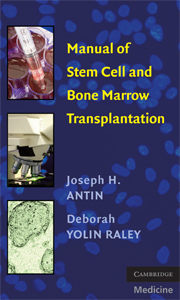Book contents
- Frontmatter
- Contents
- Acknowledgments
- Manual of Stem Cell and Bone Marrow Transplantation
- 1 Rationale for Transplantation
- 2 Types of Transplantation
- 3 HLA Matching in Allogeneic Transplantation
- 4 Stem Cell Source
- 5 Pretransplant Evaluation and Counseling of Patient and Donor
- 6 Conditioning Regimens
- 7 Stem Cell Infusion
- 8 ABO Compatibility
- 9 Engraftment
- 10 Preventative Care
- 11 Transplant-Related Complications
- 12 Graft-Versus-Host Disease – Prophylaxis and Acute
- 13 Graft-Versus-Host Disease – Chronic
- 14 Engraftment Syndrome
- 15 Infectious Disease
- 16 Graft Rejection And Failure
- 17 Gastrointestinal Complications
- 18 Pulmonary Complications
- 19 Veno-Occlusive Disease
- 20 Special Transfusion-Related Situations
- 21 Cardiovascular Complications
- 22 Neurologic Complications
- 23 Cystitis
- 24 Donor Lymphocyte Infusion
- 25 Transplantation: Regulation And Accreditation
- Appendix
- Index
7 - Stem Cell Infusion
Published online by Cambridge University Press: 23 November 2009
- Frontmatter
- Contents
- Acknowledgments
- Manual of Stem Cell and Bone Marrow Transplantation
- 1 Rationale for Transplantation
- 2 Types of Transplantation
- 3 HLA Matching in Allogeneic Transplantation
- 4 Stem Cell Source
- 5 Pretransplant Evaluation and Counseling of Patient and Donor
- 6 Conditioning Regimens
- 7 Stem Cell Infusion
- 8 ABO Compatibility
- 9 Engraftment
- 10 Preventative Care
- 11 Transplant-Related Complications
- 12 Graft-Versus-Host Disease – Prophylaxis and Acute
- 13 Graft-Versus-Host Disease – Chronic
- 14 Engraftment Syndrome
- 15 Infectious Disease
- 16 Graft Rejection And Failure
- 17 Gastrointestinal Complications
- 18 Pulmonary Complications
- 19 Veno-Occlusive Disease
- 20 Special Transfusion-Related Situations
- 21 Cardiovascular Complications
- 22 Neurologic Complications
- 23 Cystitis
- 24 Donor Lymphocyte Infusion
- 25 Transplantation: Regulation And Accreditation
- Appendix
- Index
Summary
AUTOLOGOUS
Stem cells are routinely cryopreserved with dimethyl sulfoxide (DMSO). These products are red blood cell (RBC) depleted before cryopreservation and thawed at 37°C water bath before infusion. They should be infused through standard 170-micron red blood cell filters.
GENERAL REACTIONS AND RESPONSE TO INFUSION TOXICITY
The infusion of hematopoietic stem cells may be associated with toxicities that are either specific to hematopoietic products or general to all blood product infusions. The following text provides a minimal guideline to the workup and management of infusional toxicities. Each anticipated toxicity is defined and a plan of action is outlined.
Bleeding
Unprocessed marrow contains approximately 20,000 units of heparin, which is infused over 1 to 4 hours. This will result in anticoagulation to a degree sufficient to result in clinical bleeding. Patients at risk are those with a history of recent surgery (e. g., recent line placement or revision), hemorrhagic cystitis, severe thrombocytopenia. However, bleeding can occur in any individual.
For a patient with a known hemorrhagic risk, the marrow should be concentrated and washed to remove heparin. If the risk factor is known before a harvest takes place, acid citrate dextrose (ACD) can be used in place of heparin as a cryopreservative, if allowed by protocol.
Infused heparin can be reversed with protamine. One mg of protamine will neutralize approximately 100 units of heparin. Maximum dose is 50 mg and the infusion rate should not exceed 5 mg/minute.
- Type
- Chapter
- Information
- Manual of Stem Cell and Bone Marrow Transplantation , pp. 34 - 36Publisher: Cambridge University PressPrint publication year: 2009



